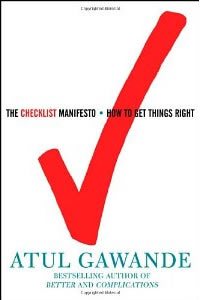Book Notes
 Atul Gawande, The Checklist Manifesto; How to Get Things Right (New York: Metropolitan Books, 2009), 209pp.
Atul Gawande, The Checklist Manifesto; How to Get Things Right (New York: Metropolitan Books, 2009), 209pp.
Before my wife had knee surgery, the surgeon handed her a magic marker and said, "Please put an 'X' on the knee we're operating on." When my daughter had surgery for a fractured clavicle, the nurse handed her a magic marker and told her to write the word "YES" on the correct shoulder. "Why the change?" I asked. "Because to some people an 'X' means 'No,'" she explained with a chuckle. How obvious! I was also amazed that in one of the best surgery facilities in the world, at least four or five times different hospital personnel asked my daughter the exact same questions: "tell us your name, date of birth, and why you are here." It felt strange that in such a highly sophisticated place such radically simple measures were taken, but I now have an inkling that the hospital had instituted something like Atul Gawande's prescription for simple checklists for highly complex tasks.
Gawande, a general surgeon and professor at Harvard, observes the daunting complexity of medicine. There are now over 6,000 drugs and 4,000 medical and surgical procedures. An Israeli study documented that a patient in ICU requires 178 individual actions in a twenty-four hour day. Rates for complications are low, but there are now about 230 million surgeries performed per year world wide, so even a low percentage of a big number means there are many complications and deaths that are preventable with a simple checklist. Checklists originated in the aviation industry, and as Gawande shows are now used in building skyscrapers, restaurants, rock concert stage sets, and financial analysis. We can thank nurses for the most basic (and important) medical checklist, the patient chart with our four vital signs (pulse, blood pressure, temperature, and respiration).
In 2001 a study at Johns Hopkins documented dramatically lower rates of line infections with the use of simple checklists. Gawande eventually joined a WHO "safe surgery checklist" program that resulted in a nineteen-point checklist that was tested in eight hospitals around the world. The results were remarkable and published in the New England Journal of Medicine in 2009. But even today only about 10% of hospitals use the WHO checklists. The culture of the rock star surgeon with "expert audacity" runs deep, Gawande admits. How can anything so simple be so important? In the last chapter of the book Gawande makes a final appeal based upon his own surgical practice: "I have yet to get through a week in surgery without the checklist's leading us to catch something we would have missed. Last week, as I write this, we had three catches in five cases" (187).


